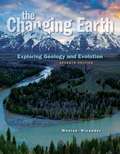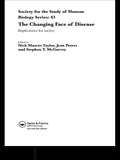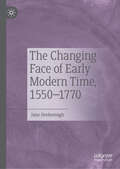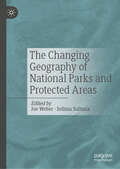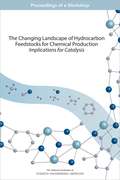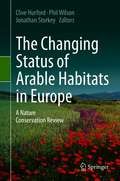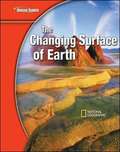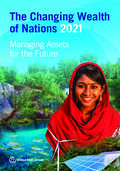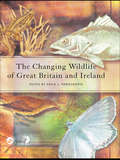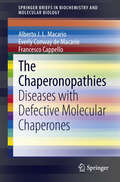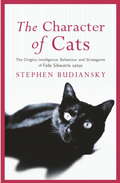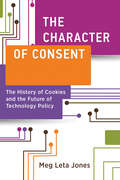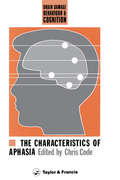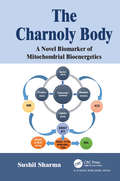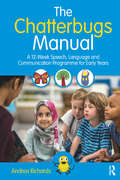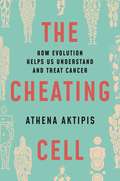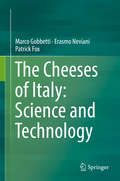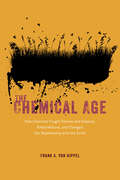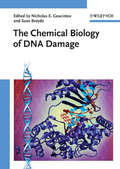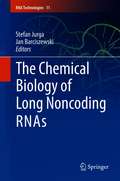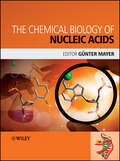- Table View
- List View
The Changing Earth (Inspire Science, Grade 7 Integrated #Unit 2)
by Douglas Fisher Ralph M. Feather Jr. Alton L. BiggsNIMAC-sourced textbook
The Changing Earth: Exploring Geology And Evolution
by Reed Wicander James S. MonroeTHE CHANGING EARTH: EXPLORING GEOLOGY AND EVOLUTION, Seventh Edition, is a member of a rare breed of texts written specifically for courses covering both physical and historical geology. Three interrelated themes (plate tectonics, organic evolution, and geologic time) help students understand that Earth is a complex, integrated, and continually changing system. <p><p> In the new edition authors James S. Monroe and Reed Wicander integrate new content emphasizing the economic impacts of geology. Topics such as fracking, nuclear waste, and the threat of earthquakes are covered in new Geo-Impact boxes that stress real-world applications. Lauded for their clear writing style, the authors go beyond simply explaining geology and its processes; rather, they place that knowledge within the context of human experience by consistently emphasizing relevance, resources, and the environment. New Global Geosciences Watch activities help students learn how to use an extensive database of articles on geology that are updated several times a day and are available exclusively for users of this book.
The Changing Face of Disease: Implications for Society (Society For The Study Of Human Biology Ser.)
by Nick Mascie-Taylor Jean Peters Stephen T. McGarveyDisease is an ever-present threat faced by all human societies. Today, this concept has become an influential area of study known as the global burden of disease, which encompasses contemporary health concerns such as the economic costs of disease, the societal impact of illness in developing nations, and infectious diseases resulting from lifestyl
The Changing Face of Early Modern Time, 1550–1770
by Jane DesboroughThis book provides a reinterpretation of early modern clock and watch dials on the basis of use. Between 1550 and the emergence of a standard format in 1770, dials represented combinations of calendrical, lunar and astronomical information using multiple concentric rings, subsidiary dials and apertures. Change was gradual, but significant. Over the course of eight chapters and with reference to thirty-five exceptional images, this book unlocks the meaning embedded within these early combinations. The true significance of dial change can only be fully understood by comparing dials with printed paper sources such as almanacs, diagrams and craft pamphlets. Clock and watch makers drew on traditional communication methods, utilised different formats to generate trust in their work, and tried to be help users in different contexts. The calendar, lunar and astronomical functions were useful as a memory prompt for astrology up until the mid-late seventeenth century. After the decline of this practice, the three functions continued to be useful for other purposes, but eventually declined.
The Changing Geography of National Parks and Protected Areas
by Joe Weber Selima SultanaThis book contains recent geographic work examining the changing geography of protected areas in the U.S. and Europe. These places can be national parks, forests, or other places that are being protected for their significant aesthetic, historical, or environmental values by governments and communities. These places can be studied with reference to their physical environments, the management of their plant and animal life, which places are to be protected, who visits these places (and who does not, and why not), and how we think of these places. This work includes examinations of many parks and issues that affect them, such as land degradation, the social and political geography involved in creating new national park units, visitation by underserved segments of the population, and the changing names of protected areas. It makes use of work using methods and data as diverse as remote sensing, nineteenth survey plats and GIS, and online visitor surveys.
The Changing Landscape of Hydrocarbon Feedstocks for Chemical Production: Proceedings of a Workshop
by Engineering Medicine National Academies of SciencesA decade ago, the U.S. chemical industry was in decline. Of the more than 40 chemical manufacturing plants being built worldwide in the mid-2000s with more than 1$ billion in capitalization, none were under construction in the United States. Today, as a result of abundant domestic supplies of affordable natural gas and natural gas liquids resulting from the dramatic rise in shale gas production, the U.S. chemical industry has gone from the world’s highest-cost producer in 2005 to among the lowest-cost producers today. The low cost and increased supply of natural gas and natural gas liquids provides an opportunity to discover and develop new catalysts and processes to enable the direct conversion of natural gas and natural gas liquids into value-added chemicals with a lower carbon footprint. The economic implications of developing advanced technologies to utilize and process natural gas and natural gas liquids for chemical production could be significant, as commodity, intermediate, and fine chemicals represent a higher-economic-value use of shale gas compared with its use as a fuel. To better understand the opportunities for catalysis research in an era of shifting feedstocks for chemical production and to identify the gaps in the current research portfolio, the National Academies of Sciences, Engineering, and Medicine conducted an interactive, multidisciplinary workshop in March 2016. The goal of this workshop was to identify advances in catalysis that can enable the United States to fully realize the potential of the shale gas revolution for the U.S. chemical industry and, as a result, to help target the efforts of U.S. researchers and funding agencies on those areas of science and technology development that are most critical to achieving these advances. This publication summarizes the presentations and discussions from the workshop.
The Changing Status of Arable Habitats in Europe: A Nature Conservation Review
by Clive Hurford Phil Wilson Jonathan StorkeyThis edited volume documents the current nature conservation status of arable habitats in Europe. Arable farming systems have evolved in the European landscape over more than ten thousand years and now occupy nearly 30% of the European land area. They support species that have life cycles closely synchronised with traditional cereal growing, many of which have experienced massive declines throughout Europe. For example, in Britain, of the 100 plant species exhibiting the greatest declines in the latter half of the 20th century, 47 were typical of arable land. Despite this the habitat and many of the species associated with it remains unprotected across much of Europe. The 22 chapters cover a range of topics, including: · Regional accounts describing the impact of changing agricultural practices on the arable flora;· The results of research and surveillance projects on the soil organisms, bryophyte flora, invertebrate fauna and pollinators of arable habitats;· The potential for designing multifunctional and resilient agricultural landscapes; The use of ex situ conservation to aid the reintroduction of rare arable plants;· Case studies illustrating how changing agricultural practices have impacted on bird populations in Europe; · The roles of remote sensing in monitoring agricultural systems; · How agri-environment schemes can help restore the biodiversity in arable habitats; and · A look forward at ways to help ensure the future security of the species associated with arable habitats. It is clear that the biodiversity of arable land throughout Europe has undergone major changes, particularly during the second half of the 20th century, and that these changes are continuing into the 21st century. We need to develop a deeper appreciation of farmland wildlife and its integration into farming systems to ensure its future security in a world where value is increasingly expressed in terms of material profit. This book is particularly relevant to practitioners, policy-makers and managers working in the fields of nature conservation, agri-environment schemes and land management, and to researchers working in the fields of conservation biology, terrestrial ecology, nature conservation, applied ecology, biodiversity, agriculture, agricultural ethics and environmental studies.
The Changing Surface of Earth
by Glencoe Mcgraw-HillDiscover the Flexibility to Teach Science Your Way!. "Glencoe Science: The Changing Surface of Earth," a module in the Glencoe Science 15 book series, provides students with accurate and comprehensive coverage of middle school National Science Education Standards. Concepts are explained in a clear, concise manner, and are integrated with a wide range of hands-on experiences, critical thinking opportunities, real-world applications, and connections to other sciences and to non-science areas of the curriculum. Co-authored by National Geographic, unparalleled graphics reinforce key concepts. A broad array of print and technology resources help differentiate and accommodate all learners. The modular approach allows you to mix and match books to meet your specific curriculum needs.
The Changing Wealth of Nations 2021: Managing Assets for the Future
by World BankIt is now clear that a narrow focus on the growth of gross domestic product (GDP) is insufficient to achieve humanity's aspirations for sustainable prosperity. Well-functioning ecosystems and educated populations are requisites for sustainable well-being. These and other too-often-neglected ingredients of national wealth must be addressed if the development path is to be sustainable. 'The Changing Wealth of Nations 2021: Managing Assets for the Future' provides the most comprehensive accounting of the wealth of nations, an in-depth analysis of the evolution of wealth, and pathways to build wealth for the future. This report--and the accompanying global database--firmly establishes comprehensive wealth as a measure of sustainability and a key component of country analytics. It expands the coverage of wealth accounts and improves our understanding of the quality of all assets, notably, natural capital. Wealth--the stock of produced, natural, and human capital--is measured as the sum of assets that yield a stream of benefits over time. Changes in the wealth of nations matter because they reflect the change in countries' assets that underpin future income. Countries regularly track GDP as an indicator of their economic progress, but not wealth, and national wealth has a more direct and long-term impact on people's lives. This report provides a new set of tools and analysis to help policy makers navigate risks and to guide collective action. Wealth accounts can be applied in macroeconomic analysis to areas of major policy concern such as climate change and natural resource management. This report can be used to look beyond GDP, to gauge nations' economic well-being, and to promote sustainable prosperity.
The Changing Wildlife of Great Britain and Ireland (Systematics Association Special Volumes Ser.)
by David L. HawksworthPeriodic comprehensive overviews of the status of the diverse organisms that make up wildlife are essential to determining trends, threats and future prospects. Just over 25 years ago, leading authorities on different kinds of wildlife came together to prepare an assessment of their status of a wide range of organisms in Great Britain and Ireland i
The Changing World and Africa
by Xinfeng Li Chunying AnThis book brings contemporary Chinese scholarship into Africa, the relations between African states, and the relations between China and Africa into focus. As China becomes the biggest partner for many African states, constructing infrastructure across the continent, Western scrutiny has increased. This book offers a comprehensive look at what Chinese scholars have encountered on the ground, as well as comparative studies of how different nations have engaged with Africa.
The Chang’E-1 Topographic Atlas of the Moon
by Chunlai Li Jianjun Liu Lingli Mu Xin Ren Wei ZuoThis atlas is based on the lunar global Digital Elevation Models (DEM) of Chang'E-1 (CE-1), and presents CCD stereo image data with digital photogrammetry. The spatial resolution of the DEM in this atlas is 500m, with horizontal accuracy of 192m and vertical accuracy of 120m. Color-shaded relief maps with contour lines are used to show the lunar topographical characteristics. The topographical data gathered by CE-1 can provide fundamental information for the study of lunar topographical, morphological and geological structures, as well as for lunar evolution research.
The Chaotic Solar Cycle (Atmosphere, Earth, Ocean & Space)
by Arnold HanslmeierThis book offers an overview of solar physics with a focus on solar activity, particularly the activity cycle. It is known that solar activity varies periodically, but there are also phases of intermittency, such as the Maunder minimum, during which solar activity is very low or high over several decades. The book provides a brief introduction to chaos theory and investigates solar activity in terms of its chaotic behavior. It also discusses how intermittent phases of solar activity have affected and can affect Earth’s climate and long-term space weather, and reviews the underlying theories relating to the solar dynamo mechanism. Furthermore, each chapter includes references to scientific literature (review articles and papers) so that readers can delve deeper into the subjects covered. This richly illustrated book will appeal to a wide readership, and is also useful as a textbook for courses in solar physics and astrophysics.
The Chaperonopathies
by Francesco Cappello Everly Conway de Macario Alberto J.L. MacarioThis Brief provides a concise review of chaperonopathies, i.e., diseases in which molecular chaperones play an etiologic-pathogenic role. Introductory chapters deal with the chaperoning system and chaperoning teams and networks, HSP-chaperone subpopulations, the locations and functions of chaperones, and chaperone genes in humans. Other chapters present the chaperonopathies in general, including their molecular features and mechanistic classification into by defect, excess, or mistake. Subsequent chapters discuss the chaperonopathies in more detail, focusing on their distinctive characteristics: primary or secondary; quantitative and/or qualitative; structural and hereditary or acquired; genetic polymorphisms; gene dysregulation; age-related; associated with cancer, chronic inflammatory conditions, and autoimmune diseases. The interconnections between the chaperoning and the immune systems in cancer development, chronic inflammation, autoimmunity, and ageing are outlined, which leads to a discussion on the future prospects of chaperonotherapy. The latter may consist of chaperone gene and protein replacement/supplementation in cases of deficiency and of gene or protein blocking when the chaperone actively promotes disease. The last chapter presents the extracellular chaperones and details on how the chaperone Hsp60 is secreted into the extracellular space and, thus, appears in the blood of cancer patients with potential to participate in carcinogenesis and chronic inflammation and autoimmunity. Chaperones as clinically useful biomarkers are mentioned when pertinent. Likewise, guidelines for clinical evaluation of chaperonopathies and for their histopathological and molecular identification are provided throughout. The book also provides extensive bibliography organized by chapter and topic with comments.
The Character of Cats
by Stephen BudianskyUnlike every other domestic animal, the cat evolved as a solitary animal, not a group-dweller. A cat in a household is almost literally a fish out of water. That cats can nonetheless get along with people and (sometimes) other cats when forced to, is testimony to a remarkable adaptability. But it also makes for an extraordinary range of behaviours. Cats have for years been the subjects of intensive research in the fields of developmental psychology, learning, emotions, brain chemistry, and perception. THE CHARACTER OF CATS is the first popular book to bring this knowledge to bear on the behaviour and nature of cats. Budiansky enables us to see that many of the things that puzzle and at times baffle or even infuriate cat owners have a rational - though often very surprising - explanation in science.
The Character of Consent: The History of Cookies and the Future of Technology Policy (Information Policy)
by Meg Leta JonesThe rich, untold origin story of the ubiquitous web cookie—what&’s wrong with it, why it&’s being retired, and how we can do better.Consent pop-ups continually ask us to download cookies to our computers, but is this all-too-familiar form of privacy protection effective? No, Meg Leta Jones explains in The Character of Consent, rather than promote functionality, privacy, and decentralization, cookie technology has instead made the internet invasive, limited, and clunky. Good thing, then, that the cookie is set for retirement in 2024. In this eye-opening book, Jones tells the little-known story of this broken consent arrangement, tracing it back to the major transnational conflicts around digital consent over the last twenty-five years. What she finds is that the policy controversy is not, in fact, an information crisis—it&’s an identity crisis.Instead of asking how people consent, Jones asks who exactly is consenting and to what. Packed into those cookie pop-ups, she explains, are three distinct areas of law with three different characters who can consent. Within (mainly European) data protection law, the data subject consents. Within communication privacy law, the user consents. And within consumer protection law, the privacy consumer consents. These areas of law have very different histories, motivations, institutional structures, expertise, and strategies, so consent—and the characters who can consent—plays a unique role in those areas of law. The Character of Consent gives each computer character its due, taking us back to their origin stories within the legal history of computing. By doing so, Jones provides alternative ways of understanding the core issues within the consent dilemma. More importantly, she offers bold new approaches to creating and adopting better tech policies in the future.
The Characteristics Of Aphasia (Brain, Behaviour and Cognition)
by Chris CodeA survey of the main behavioural characteristics or symptoms of aphasia, which presents a series of essays on the history and current developments in this field of neuropsychological research. Contributors discuss recovery, rehabilitation and other contemporary issues.
The Charnoly Body: A Novel Biomarker of Mitochondrial Bioenergetics
by Sushil SharmaDiversified physicochemical injuries trigger Charnoly body (CB) formation as pleomorphic, electron-dense, multi-lamellar stacks of nonfunctional mitochondrial membranes in the most vulnerable cell. Free radicals induce downregulation of mitochondrial DNA, microRNA, AgNOR, and epigenetics to trigger CB molecular pathogenesis. CB is eliminated by energy (ATP)-driven lysosome-dependent charnolophagy as a basic molecular mechanism of intracellular detoxification to prevent acute and chronic diseases. Accumulation of CB at the junction of axon hillock and charnolosome (CS) at the synapses causes cognitive impairments; whereas, nonspecific induction of CB causes GIT stress, myelosuppression, alopecia, neurotoxicity, cardiotoxicity, and infertility in multidrug-resistant malignancies. Hence, stem cell-specific CB, charnolophagy, and CS agonists/antagonists are introduced as novel charnolopharmacotherapeutics for the successful treatment of cardiovascular diseases, neurodegenerative diseases, infectious diseases, drug addiction, and cancer. Nanoparticles to improve drug delivery, CS exocytosis, and disease-specific spatiotemporal charnolosomics employing correlative and combinatorial bioinformatics boost mitochondrial bioenergetics through balanced diet, exercise, and antioxidants. The book will be of interest to medical scientists and practitioners.
The Chatterbugs Manual: A 12-Week Speech, Language and Communication Programme for Early Years
by Andrea RichardsThe Chatterbugs Manual is a practical resource for all those supporting the development of the foundation communication skills of attention and listening, turn-taking and early vocabulary in children. The Chatterbugs programme has been designed to bridge the gap between education and specialist speech, language and communication provision, specifically with Early Years mainstream settings in mind. It enables school staff to prepare children—including those with delayed communication skills, EAL learners, or children with suspected special education needs—for learning in school by developing their communication skills through the use of robust communication strategies. The Chatterbugs Manual contains: An overview of the programme, including step-by-step instructions on how to plan and deliver a Chatterbugs session Guidance on identifying children likely to benefit from the programme Progress Tracking documents, along with information on measuring outcomes Child-friendly, illustrated session resources Frequently Asked Questions A parent-friendly information leaflet Information on models of implementation Information on accessing training and support Developed by an experienced speech and language therapist, Chatterbugs has consistently recorded successful outcomes for over 80% of participants since the programme’s inception in 2012, and for over 90% of participants since 2016. With its hands-on approach, the programme is an essential resource for educators, support staff, and speech and language therapists working with Early Years children.
The Cheating Cell: How Evolution Helps Us Understand and Treat Cancer
by Athena AktipisA fundamental and groundbreaking reassessment of how we view and manage cancer When we think of the forces driving cancer, we don’t necessarily think of evolution. But evolution and cancer are closely linked, for the historical processes that created life also created cancer. The Cheating Cell delves into this extraordinary relationship, and shows that by understanding cancer’s evolutionary origins, researchers can come up with more effective, revolutionary treatments.Athena Aktipis goes back billions of years to explore when unicellular forms became multicellular organisms. Within these bodies of cooperating cells, cheating ones arose, overusing resources and replicating out of control, giving rise to cancer. Aktipis illustrates how evolution has paved the way for cancer’s ubiquity, and why it will exist as long as multicellular life does. Even so, she argues, this doesn’t mean we should give up on treating cancer—in fact, evolutionary approaches offer new and promising options for the disease’s prevention and treatments that aim at long-term management rather than simple eradication. Looking across species—from sponges and cacti to dogs and elephants—we are discovering new mechanisms of tumor suppression and the many ways that multicellular life-forms have evolved to keep cancer under control. By accepting that cancer is a part of our biological past, present, and future—and that we cannot win a war against evolution—treatments can become smarter, more strategic, and more humane.Unifying the latest research from biology, ecology, medicine, and social science, The Cheating Cell challenges us to rethink cancer’s fundamental nature and our relationship to it.
The Cheeses of Italy: Science And Technology
by Marco Gobbetti Erasmo Neviani Patrick FoxThe book will contain a detailed description on the historical aspects of cheese manufacture, a culmination of historical information on the most traditional and worldwide popular Italian cheese varieties. An overview on cheese production is also included, covering the main general aspects. An overall classification of Italian cheeses will follow, aiming to categorize all the cheese varieties that have a tradition and/or an economic importance. Based on a large literature review, the core of the book will include descriptions cheese making traits which are unique to Italian cheese biotechnology. In particular, the milk chemical composition, the use whey or milk natural starters, some technology options (e.g., curd cooking), the microbiota composition and metabolism during curd ripening, especially for cheese made with raw milk, and the main relevant biochemical events, which occur during the very long-time ripening, will be described. The last part of the book will consider a detailed description of the biotechnology for the manufacture of the most traditional and popular cheeses worldwide.
The Chemical Age: How Chemists Fought Famine and Disease, Killed Millions, and Changed Our Relationship with the Earth
by Frank A. von HippelFor thousands of years, we’ve found ways to scorch, scour, and sterilize our surroundings to make them safer. Sometimes these methods are wonderfully effective. Often, however, they come with catastrophic consequences—consequences that aren’t typically understood for generations. The Chemical Age tells the captivating story of the scientists who waged war on famine and disease with chemistry. With depth and verve, Frank A. von Hippel explores humanity’s uneasy coexistence with pests, and how their existence, and the battles to exterminate them, have shaped our modern world. Beginning with the potato blight tragedy of the 1840s, which led scientists on an urgent mission to prevent famine using pesticides, von Hippel traces the history of pesticide use to the 1960s, when Rachel Carson’s Silent Spring revealed that those same chemicals were insidiously damaging our health and driving species toward extinction. Telling the story of these pesticides in vivid detail, von Hippel showcases the thrills and complex consequences of scientific discovery. He describes the invention of substances that could protect crops, the emergence of our understanding of the way diseases spread, the creation of chemicals used to kill pests and people, and, finally, how scientists turned those wartime chemicals on the landscape at a massive scale, prompting the vital environmental movement that continues today. The Chemical Age is a dynamic, sweeping history that exposes how humankind’s affinity for pesticides made the modern world possible—while also threatening its essential fabric.
The Chemical Biology of DNA Damage
by Nicholas E. Geacintov Suse BroydeBringing the power of biochemical analysis to toxicology, this modern reference explains genotoxicity at the molecular level, showing the links between a DNA lesion and the resulting cellular or organismic response. Clearly divided into two main sections, Part 1 focuses on selected examples of important DNA lesions and their biological impact, while the second part covers current advances in assessing and predicting the genotoxic effects of chemicals, taking into account the biological responses mediated by the DNA repair, replication and transcription machineries. A ready reference for biochemists, toxicologists, molecular and cell biologists, and geneticists seeking a better understanding of the impact of chemicals on human health.
The Chemical Biology of Long Noncoding RNAs (RNA Technologies #11)
by Jan Barciszewski Stefan JurgaThis book offers a comprehensive and detailed overview of various aspects of long non-coding RNAs. It discusses their emerging significance in molecular medicine, ranging from human cancers to cardiovascular and metabolic diseases. Transcriptomic studies have demonstrated that the majority of genomes found in complex organisms are expressed in highly dynamic and cell-specific patterns, producing huge numbers of intergenic, antisense and intronic long non-protein-coding RNAs (lncRNAs). Thousands of lncRNAs have been identified, and unlike mRNA, they have no protein-coding capacity. A large repertoire of ncRNAs, actively transcribed from the mammalian genome, control diverse cellular processes, both in terms of development and diseases, through a variety of gene regulatory mechanisms. IncRNAs have emerged as a new paradigm in epigenetic regulation of the genome. Given its scope, the book will be of particular interest to molecular, chemical, cell and developmental biologists, as well as specialists in translational medicine involved in disease-oriented research. It also offers a valuable resource for in silico experts seeking a deeper understanding of lncRNA expression and function through computational analysis of the NGS data.
The Chemical Biology of Nucleic Acids
by Günter MayerWith extensive coverage of synthesis techniques and applications, this text describes chemical biology techniques which have gained significant impetus during the last five years. It focuses on the methods for obtaining modified and native nucleic acids, and their biological applications. Topics covered include: chemical synthesis of modified RNAexpansion of the genetic alphabet in nucleic acids by creating new base pairschemical biology of DNA replication: probing DNA polymerase selectivity mechanisms with modified nucleotidesnucleic-acid-templated chemistrychemical biology of peptide nucleic acids (PNA)the interactions of small molecules with DNA and RNAthe architectural modules of folded RNAsgenesis and biological applications of locked nucleic acid (LNA)small non-coding RNA in bacteriamicroRNA-guided gene silencingnucleic acids based therapiesinnate immune recognition of nucleic acidlight-responsive nucleic acids for the spatiotemporal control of biological processesDNA methylationframeworks for programming RNA devicesRNA as a catalyst: The Diels-Alderase-Ribozymeevolving an understanding of RNA function by in vitro approachesthe chemical biology of aptamers: synthesis and applicationsnucleic acids as detection toolsbacterial riboswitch discovery and analysisThe Chemical Biology of Nucleic Acids is an essential compendium of the synthesis of nucleic acids and their biological applications for bioorganic chemists, chemical biologists, medicinal chemists, cell biologists, and molecular biologists.

